Tag: kindermusik near me
Rocking and a-Rolling Trains the Brain for Balance
By Debbie Mondale, Accredited Kindermusik Educator
Do you wonder why it is so important for our babies to rock and roll – move freely… and why toddlers love repeatedly falling over on purpose or preschool-age children spin themselves silly?
Balancing is not a skill we are born with, it must be trained in coordination with our body and brain. The good news, training for this cognitive development is natural and FUN, and this is a skill that impacts us every day of our entire lives, even essential for our survival. Encouraging children to move creatively is a good start, AND there are many mommy and me type activities that enhance this process.
The movements of our little one’s bodies train their brain to know how their body is positioned in the space around them, where UP is, and how to balance. The video below shows a pretty cool way to demonstrate this vestibular system as it occurs in the inner ear and sends messages to train the brain for balance and so much more.
View this post on Instagram
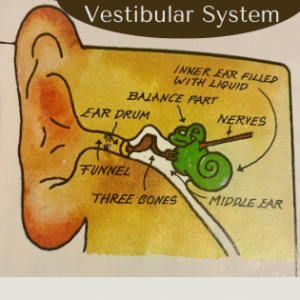
Usborne – How Your Body Works – 1975
The inner ear is a curled up tube with three extra loops which are filled with a liquid, somewhat like the balloon in the video. These loops are also filled with nerves, that go with the flow as we move around and send messages to the brain. As the head and body moves, the liquid stays level with the ground, and the nerve endings tilt from their secured end as the liquid moves. Messages about HOW these nerve endings move are sent to the brain to create neural connections that allow us to subconsciously balance and move through space effectively.
When rolling and spinning round and round, the liquid in the ear whirls around too, even for a little while after stopping, which leaves a bit of a dizzying feeling which children LOVE (adults?… not so much). Spinning sends totally unique messages about balance to the brain and improves focus since coordinating both sides of the body and brain are required.
The more your child’s body moves, in every which way, the more they will be able to coordinate their actions to dance, ride a bike, play sports, and problem solve situations in which they become off balance, stuck, or disoriented.
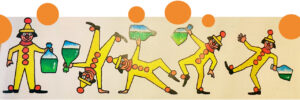
Usborne – How Your Body Works – 1975
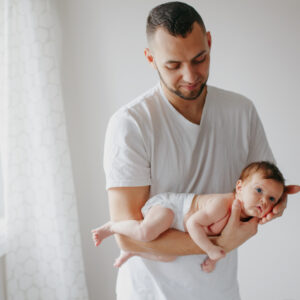
Think about the last time your body instinctively recovered after you stumbled on uneven ground. Have you ever been disoriented under water after a wave knocked you over? These are the moments when all this vestibular training kicks in to save the day.
Movements you do with them, such as rocking, dancing with mom, wrestling with dad, and even fun pillow fights with the family are training the brain. I remember when my son was young, he loved being carried upside down. He insisted for almost a year that THAT is how he wanted to be taken to the bathroom to brush his teeth!
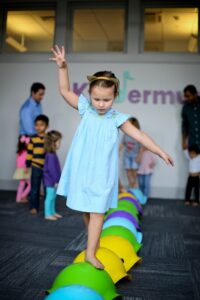
Movements they do for themselves, like nodding or shaking their head, rolling on the ground, falling down, spinning, jumping, tumbling… are naturally processing cognitive development in your child. If you see your child repeating a movement ad nauseum, their brain is actively SEEKING this type of stimulation.
ONE occurrence only makes the brain aware it is an option. Only thousands of repetitions can truly build the neural connections needed to make these reactions instinctual enough to act without thinking about it in an emergency situation. Early childhood development specialists WISH they could share this parenting advice to all young families since the first five years is a critical period for this brain development.
Our job can be as simple as making sure they are in a safe place to move and let them GO! Add maybe add some language development to the mix by describing their actions and how it makes them feel. Adding delightful music during movement multiplies the fun factor and increases their attention span. Download the free Kindermusik APP and get the action going with the songs in the Themes: Body and Playtime.
- As your child becomes more capable, challenge them with creative obstacles that make it fun to move their body in unique ways.
- Indoor diy obstacle courses can include piles of pillows and blanket tunnels and fun objects to pick up and toss in baskets. This can be set up in a living room, or even a hallway to keep them on a forward path.
- It can be so fun to set up their own little ninja warrior outdoor obstacle course with balancing beams, wobbly surfaces, things that spin, tunnels, rolling and tumbling paths, and so much more.
Our Kindermusik curriculum makes this all easy for you as it is designed to provide your child with a wide variety of movement experience. And our Accredited Educators here in Central Florida are specialists that will teach you more about it and provide tools you can use to meet your child’s unique needs for developing their gross motor skills and vestibular capabilities. Join us for a $5 preview class and see the magic in action.
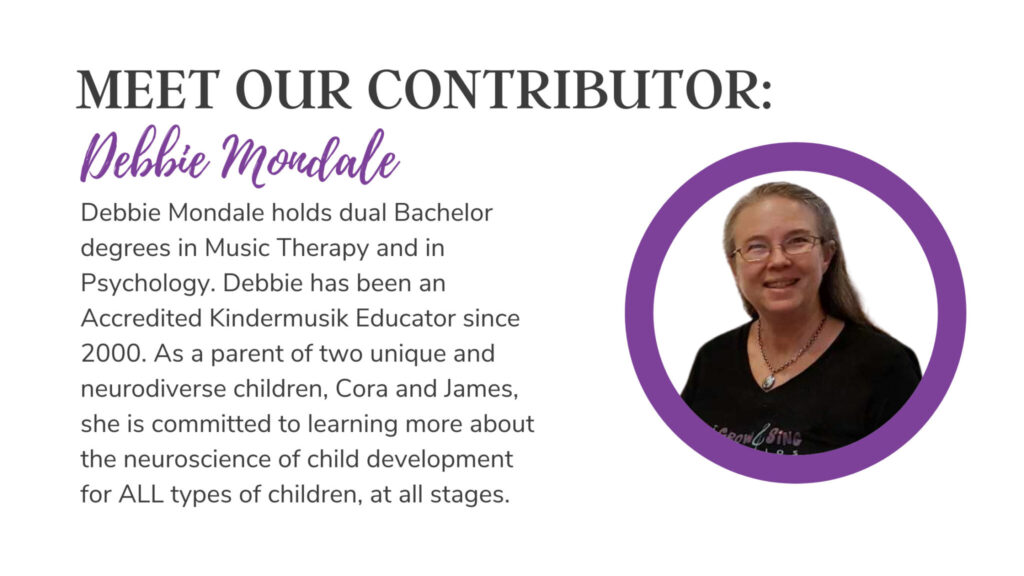
The Gift of Time
What is something you absolutely love to do? What are you good at? What is your favorite band? Who are your best friends?
Now, imagine how different your path with any of these things would be if you only went by your very first impression. Did you know instantly that you loved to do that thing? Or did you need to try a few times before you realized it was something you liked to do, or were good at. Maybe running, or dancing, or sports. What about your favorite song or band? Did you sing along the first time you heard it?
Think about it. How long does it take you to sing along to a song? I mean ACTUALLY SING ALONG. On first listen, you are most likely processing. Thinking about if you would like to hear it again. The second time, you may be tapping your foot, or humming along. The third time, maybe you are singing along to the chorus. You get the idea. It takes time to process experiences. It takes time to decide if it’s something we want to do again. It takes us time to form relationships, or skills.
As parents, we just want our kids to be happy. We want them to have fun, and feel safe. But the truth is, there’s growth in a bit of the unknown, in the processing.
Tim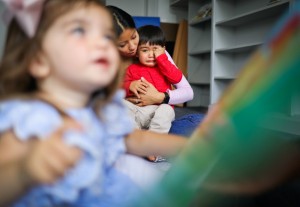 e and time again, we witness families with their babies or toddlers in a first time preview of one of our music classes. New experiences are challenging for children and adults. It takes time to process new environments and take it all in. Many times, as young children are easing into their first class, they may be quiet, cry, or even the opposite, it may overexcite them. This is all part of processing and it’s only the first impression. In fact, what we are really talking about here is a parent’s first impression of their child’s first impression.
e and time again, we witness families with their babies or toddlers in a first time preview of one of our music classes. New experiences are challenging for children and adults. It takes time to process new environments and take it all in. Many times, as young children are easing into their first class, they may be quiet, cry, or even the opposite, it may overexcite them. This is all part of processing and it’s only the first impression. In fact, what we are really talking about here is a parent’s first impression of their child’s first impression.
“She’s never like this at home”. We hear this a lot. As educators, we aren’t surprised. Why? Because Kindermusik is a sensory rich environment filled with sights, sounds, socialization, brain work, team work and the list goes on. It would be surprising to think that a child isn’t processing this new environment. To either clam up quietly as an observer, or to run around wildly as a kinesthetic learner. All of this is part of the first impression. When a parent decides to not enroll based on this first impression, could it be that so much learning and growth opportunities are missed? Imagine an environment that allows for these first impression moments in a non-judgmental way, and allows for a 2nd, 3rd or even 4th impression before making a final decision. Imagine the possibilities.
Consider giving your child the gift of time.
 Holly Lesnick is a Licensed Kindermusik Educator and Studio owner at Grow and Sing Studios, a Bachelor of Music Therapy, mom of 2 and celebrated 20 years of marriage with her husband Will. Holly is the Kindermusik International Brand Ambassador for the U.S., and always happy to collaborate with brands she believes in.
Holly Lesnick is a Licensed Kindermusik Educator and Studio owner at Grow and Sing Studios, a Bachelor of Music Therapy, mom of 2 and celebrated 20 years of marriage with her husband Will. Holly is the Kindermusik International Brand Ambassador for the U.S., and always happy to collaborate with brands she believes in.
www.growandsing.com
Click here for offer for new families to Grow and Sing Studios.